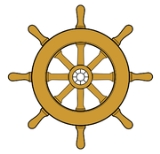
Ship's wheel
Encyclopedia
A ship's wheel is the modern method of adjusting the angle of a boat
or ship
's rudder
in order to cause the vessel to change its course. Together with the rest of the steering
mechanism it forms part of the helm. It is typically connected to a mechanical, electric servo
, or hydraulic system. In some modern ships the wheel is replaced with a simple toggle that remotely controls an electro-mechanical or electro-hydraulic drive for the rudder, with a rudder position indicator presenting feedback to the helmsman.
Helmsmen
on older ships used a tiller
(a horizontal bar fitted directly to the top of the rudder post) or a whipstaff (a vertical stick acting on a tiller).
Early ships' wheels (c. 1700) were operated to correspond to the motion of the tiller, with a clockwise motion (corresponding to a right tiller motion) turning the rudder and thus the ship to the left. Eventually the control direction of the wheel was reversed to make it more consistent with the action of a motor vehicle's steering wheel The design of ships' wheels probably influenced that of the modern steering wheel
.
Boat
A boat is a watercraft of any size designed to float or plane, to provide passage across water. Usually this water will be inland or in protected coastal areas. However, boats such as the whaleboat were designed to be operated from a ship in an offshore environment. In naval terms, a boat is a...
or ship
Ship
Since the end of the age of sail a ship has been any large buoyant marine vessel. Ships are generally distinguished from boats based on size and cargo or passenger capacity. Ships are used on lakes, seas, and rivers for a variety of activities, such as the transport of people or goods, fishing,...
's rudder
Rudder
A rudder is a device used to steer a ship, boat, submarine, hovercraft, aircraft or other conveyance that moves through a medium . On an aircraft the rudder is used primarily to counter adverse yaw and p-factor and is not the primary control used to turn the airplane...
in order to cause the vessel to change its course. Together with the rest of the steering
Steering
Steering is the term applied to the collection of components, linkages, etc. which will allow a vessel or vehicle to follow the desired course...
mechanism it forms part of the helm. It is typically connected to a mechanical, electric servo
Servomechanism
thumb|right|200px|Industrial servomotorThe grey/green cylinder is the [[Brush |brush-type]] [[DC motor]]. The black section at the bottom contains the [[Epicyclic gearing|planetary]] [[Reduction drive|reduction gear]], and the black object on top of the motor is the optical [[rotary encoder]] for...
, or hydraulic system. In some modern ships the wheel is replaced with a simple toggle that remotely controls an electro-mechanical or electro-hydraulic drive for the rudder, with a rudder position indicator presenting feedback to the helmsman.
Helmsmen
Helmsman
A helmsman is a person who steers a ship, sailboat, submarine, or other type of maritime vessel. On small vessels, particularly privately-owned noncommercial vessels, the functions of skipper and helmsman may be combined in one person. On larger vessels, there is a separate officer of the watch,...
on older ships used a tiller
Tiller
A tiller or till is a lever attached to a rudder post or rudder stock of a boat that provides leverage for the helmsman to turn the rudder...
(a horizontal bar fitted directly to the top of the rudder post) or a whipstaff (a vertical stick acting on a tiller).
Early ships' wheels (c. 1700) were operated to correspond to the motion of the tiller, with a clockwise motion (corresponding to a right tiller motion) turning the rudder and thus the ship to the left. Eventually the control direction of the wheel was reversed to make it more consistent with the action of a motor vehicle's steering wheel The design of ships' wheels probably influenced that of the modern steering wheel
Steering wheel
A steering wheel is a type of steering control in vehicles and vessels ....
.

